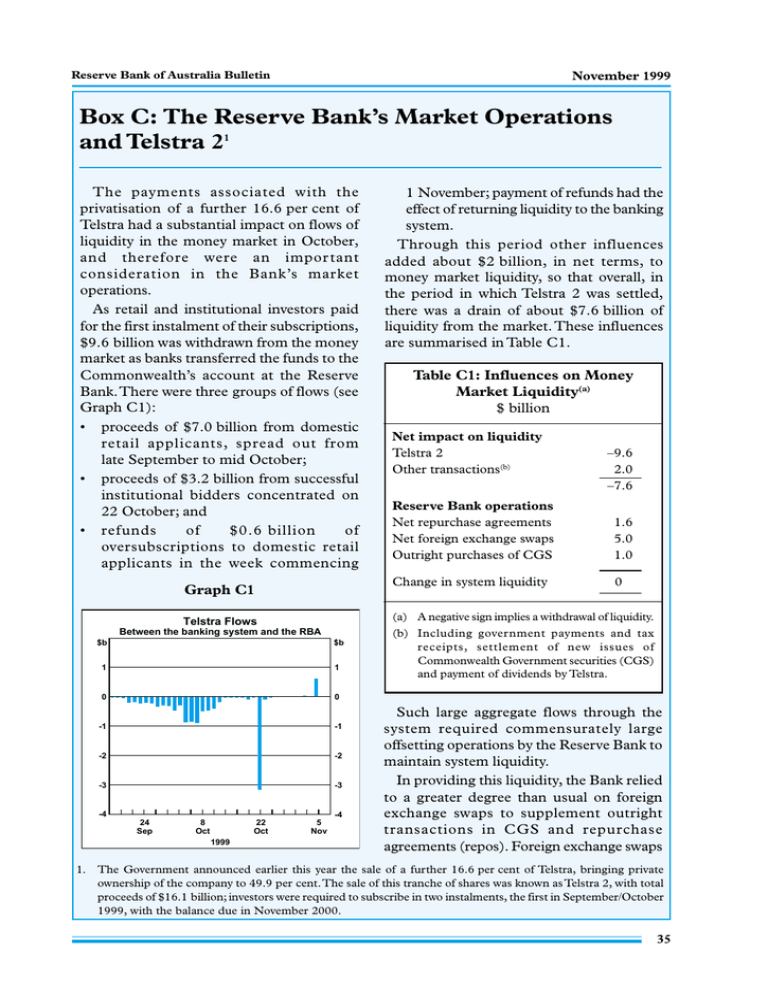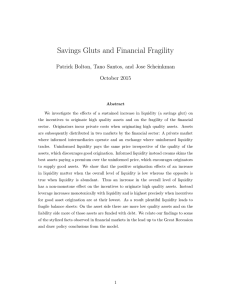Box C: The Reserve Bank’s Market Operations and Telstra 2
advertisement

Reserve Bank of Australia Bulletin November 1999 Box C: The Reserve Bank’s Market Operations and Telstra 21 The payments associated with the privatisation of a further 16.6 per cent of Telstra had a substantial impact on flows of liquidity in the money market in October, and therefore were an impor tant consideration in the Bank’s market operations. As retail and institutional investors paid for the first instalment of their subscriptions, $9.6 billion was withdrawn from the money market as banks transferred the funds to the Commonwealth’s account at the Reserve Bank. There were three groups of flows (see Graph C1): • proceeds of $7.0 billion from domestic retail applicants, spread out from late September to mid October; • proceeds of $3.2 billion from successful institutional bidders concentrated on 22 October; and • refunds of $0.6 billion of oversubscriptions to domestic retail applicants in the week commencing Graph C1 $b $b 1 1 0 0 -1 -1 -2 -2 -3 -3 -4 -4 8 Oct 22 Oct 1999 Table C1: Influences on Money Market Liquidity(a) $ billion Net impact on liquidity Telstra 2 Other transactions(b) –9.6 2.0 –7.6 Reserve Bank operations Net repurchase agreements Net foreign exchange swaps Outright purchases of CGS 1.6 5.0 1.0 Change in system liquidity 0 (a) A negative sign implies a withdrawal of liquidity. Telstra Flows Between the banking system and the RBA 24 Sep 1 November; payment of refunds had the effect of returning liquidity to the banking system. Through this period other influences added about $2 billion, in net terms, to money market liquidity, so that overall, in the period in which Telstra 2 was settled, there was a drain of about $7.6 billion of liquidity from the market. These influences are summarised in Table C1. 5 Nov (b) Including government payments and tax receipts, settlement of new issues of Commonwealth Government securities (CGS) and payment of dividends by Telstra. Such large aggregate flows through the system required commensurately large offsetting operations by the Reserve Bank to maintain system liquidity. In providing this liquidity, the Bank relied to a greater degree than usual on foreign exchange swaps to supplement outright transactions in CGS and repurchase agreements (repos). Foreign exchange swaps 1. The Government announced earlier this year the sale of a further 16.6 per cent of Telstra, bringing private ownership of the company to 49.9 per cent. The sale of this tranche of shares was known as Telstra 2, with total proceeds of $16.1 billion; investors were required to subscribe in two instalments, the first in September/October 1999, with the balance due in November 2000. 35 Semi-Annual Statement on Monetary Policy are similar to repurchase agreements, except they involve the exchange of cash for foreign currency rather than securities. Under the swaps in question, the first leg involved the Bank exchanging Australian dollars for foreign currency (thereby adding to the supply of Australian dollars in the money market) with the transactions to be reversed in the second leg, which in most cases is scheduled for the first quarter of 2000 (though some swaps may, of course, be rolled forward). After allowing for operations to shift funds within the period, the Bank accommodated the net outflow by undertaking an additional $1.6 billion of repos (increasing its repo book to about $7 billion) and $5 billion in foreign exchange swaps. The remainder was undertaken through outright purchases of CGS. The increased use of foreign exchange swaps has lifted the Bank’s outstanding forward foreign exchange commitments to about $16 billion. This rise was matched by a counterpart rise in the Bank’s holdings of foreign assets, and therefore had no effect on the Reserve Bank’s net foreign reserves position. 36 November 1999 The Bank has used foreign exchange swaps to manage domestic liquidity at various times in the past, though their use on this occasion was heavier than usual, for two reasons. First, as the Government has been running budget surpluses, the stock of CGS outstanding has fallen. Exclusive reliance on transactions in CGS – either as outright purchases or via repos – to provide liquidity on the scale required for settlement of Telstra 2 could have caused distortions in the CGS market itself or in the repo market. Second, the Bank is also aware that preparations forY2K could see banks’ demand for liquidity rise, perhaps substantially. In that context, the relative reliance on foreign exchange swaps to manage the liquidity implications of Telstra 2 leaves a larger pool of CGS available to banks to manage their liquidity as Y2K approaches. This will also provide greater operational flexibility to the Reserve Bank through this period. It is possible also that the Bank will continue to rely to a greater extent than normal on foreign exchange swaps to provide system liquidity ahead of Y2K. R






